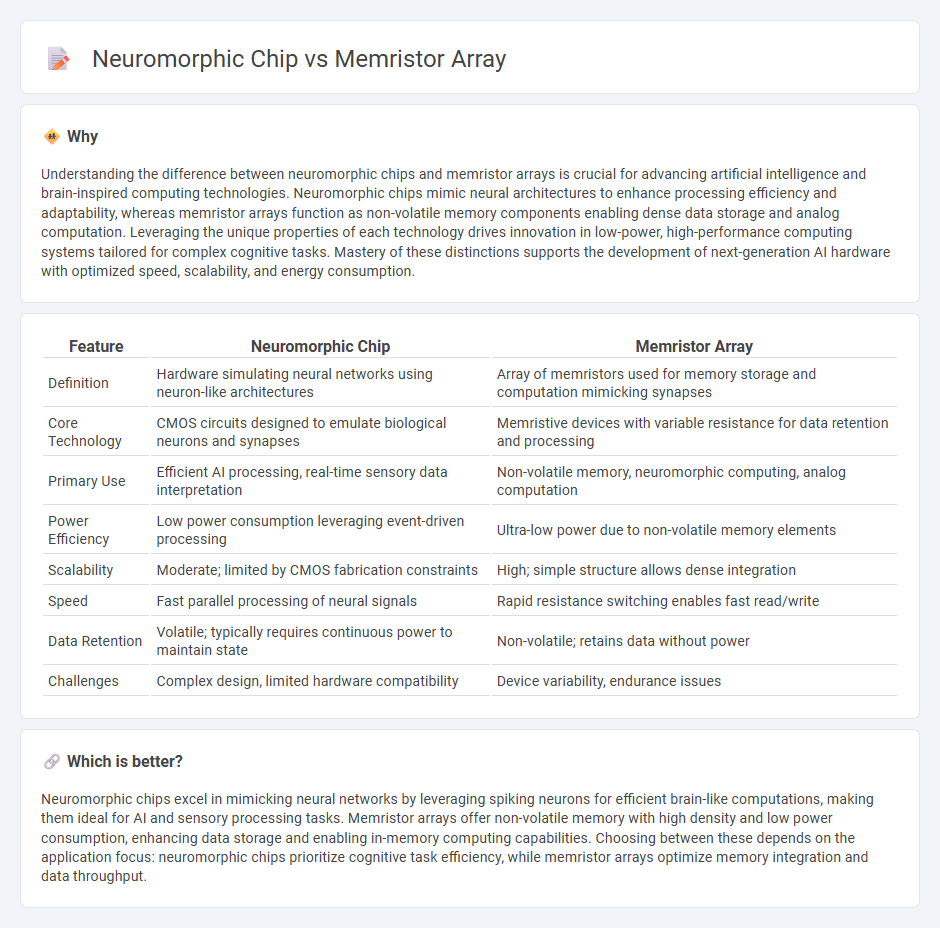
Neuromorphic chips mimic the human brain's neural architecture to enhance computing efficiency and power consumption, while memristor arrays provide non-volatile memory storage with fast processing speeds by emulating synaptic functions. Both technologies play crucial roles in advancing artificial intelligence and machine learning hardware by improving data processing and energy efficiency. Explore how neuromorphic chips and memristor arrays are revolutionizing the future of computing.
Why it is important
Understanding the difference between neuromorphic chips and memristor arrays is crucial for advancing artificial intelligence and brain-inspired computing technologies. Neuromorphic chips mimic neural architectures to enhance processing efficiency and adaptability, whereas memristor arrays function as non-volatile memory components enabling dense data storage and analog computation. Leveraging the unique properties of each technology drives innovation in low-power, high-performance computing systems tailored for complex cognitive tasks. Mastery of these distinctions supports the development of next-generation AI hardware with optimized speed, scalability, and energy consumption.
Comparison Table
| Feature | Neuromorphic Chip | Memristor Array |
|---|---|---|
| Definition | Hardware simulating neural networks using neuron-like architectures | Array of memristors used for memory storage and computation mimicking synapses |
| Core Technology | CMOS circuits designed to emulate biological neurons and synapses | Memristive devices with variable resistance for data retention and processing |
| Primary Use | Efficient AI processing, real-time sensory data interpretation | Non-volatile memory, neuromorphic computing, analog computation |
| Power Efficiency | Low power consumption leveraging event-driven processing | Ultra-low power due to non-volatile memory elements |
| Scalability | Moderate; limited by CMOS fabrication constraints | High; simple structure allows dense integration |
| Speed | Fast parallel processing of neural signals | Rapid resistance switching enables fast read/write |
| Data Retention | Volatile; typically requires continuous power to maintain state | Non-volatile; retains data without power |
| Challenges | Complex design, limited hardware compatibility | Device variability, endurance issues |
Which is better?
Neuromorphic chips excel in mimicking neural networks by leveraging spiking neurons for efficient brain-like computations, making them ideal for AI and sensory processing tasks. Memristor arrays offer non-volatile memory with high density and low power consumption, enhancing data storage and enabling in-memory computing capabilities. Choosing between these depends on the application focus: neuromorphic chips prioritize cognitive task efficiency, while memristor arrays optimize memory integration and data throughput.
Connection
Neuromorphic chips utilize memristor arrays to mimic synaptic functionalities in artificial neural networks, enabling efficient data processing and storage. Memristors offer non-volatile memory and analog signal modulation, crucial for replicating the plasticity of biological synapses within neuromorphic architectures. This integration significantly enhances computational speed and energy efficiency in brain-inspired computing systems.
Key Terms
Synaptic Weight Storage
Memristor arrays offer high-density synaptic weight storage through their non-volatile and analog resistance states, enabling efficient representation of neural network parameters. Neuromorphic chips integrate memristors or other storage technologies with specialized circuits to emulate synaptic behaviors and plasticity, optimizing real-time learning and energy consumption. Explore in-depth comparisons of synaptic weight storage mechanisms and their impact on neuromorphic computing performance.
Parallel Processing
Memristor arrays excel in parallel processing by enabling simultaneous data storage and computation directly within the memory hardware, reducing latency and energy consumption compared to traditional architectures. Neuromorphic chips mimic the brain's neural networks to efficiently process information in parallel, leveraging spiking neurons and synaptic plasticity for adaptive learning and real-time data handling. Explore how these technologies revolutionize parallel processing paradigms and their applications in AI and edge computing.
Analog Computation
Memristor arrays leverage resistive memory elements to perform in-memory analog computation, significantly reducing data movement and energy consumption compared to traditional digital processors. Neuromorphic chips emulate biological neural networks using mixed-signal circuits optimized for parallel processing and adaptive learning, enhancing performance in brain-inspired tasks. Explore the differences and advantages of these technologies to understand their roles in advancing analog computation.
Source and External Links
Memristor Crossbar Array with Enhanced Device Yield for In ... - Presents a fabrication strategy for high-yield Al2O3/TiOx bilayer memristor crossbar arrays, achieving over 98% device yield and demonstrating 100% accuracy in a 5x5 image classification task using in-memory computing.
Memristive Crossbar Arrays for Storage and Computing Applications - Surveys memristive crossbar arrays as promising architectures for data storage and neuromorphic computing, highlighting their ability to colocate memory and processing units and addressing challenges like sneak-path currents.
Programming memristor arrays with arbitrarily high precision for ... - Demonstrates methods enabling memristor arrays to perform vector-matrix multiplication with extremely high precision by sequentially programming devices to compensate residual errors, enhancing energy efficiency over digital computing.
 dowidth.com
dowidth.com